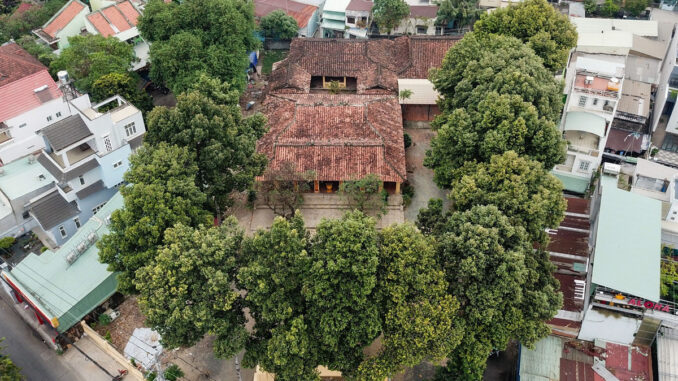
HO CHI MINH CITY – Dinh Linh Dong, built in 1823, worships Mr. Ta Duong Minh, who reclaimed the village of Thu Duc land in the 17th century.
Dinh Linh Dong was built in 1823, now located on Chuong Duong street, Linh Chieu ward, Thu Duc district. The temple is located on a high mound, with an area of nearly 2,500 m2.
In addition to worshiping the village god, the communal house is also a place where Mr. Ta Duong Minh, who publicly explores the land of Thu Duc. His title is Thu Duc, the leader of the Chinese minority “Bai Thanh Phuc Minh” who immigrated to Vietnam.
Around the year 1679-1725, he and a number of Vietnamese, Champa and Chan Lap residents reclaimed this wasteland, expanded cultivation and established a career. His nickname was later taken to name the land of Thu Duc.

Initially, Linh Dong communal house architecture can be built on a small scale and using lightweight materials. In later time, the architecture of the communal house has changed more and more spaciously, more solemnly with brick walls, tile roofs, wooden structures. The facade facing the East-South direction, built in the form of Tam, includes works such as electricity bill, middle electricity, main hall, guest house, communal yard …

The large communal courtyard, in the center is a screen depicting the dragon and tiger image; two common animals in Vietnamese folk life.

The pavilions of Linh Dong communal house are covered with yin and yang tiled roofs. On the top of the main hall, there is a statue of bipolar painting Chau made of green glazed ceramic, common architecture in Vietnamese communal house.

The front of the main hall has the familiar red and yellow tones in the communal house of Nam Bo village. The main hall is in the form of four pillars with 32 wooden pillars supporting the entire roof. The door system of the communal house used to be also made of wood, but now it is replaced by iron due to termites, rotting and structural damage.

Inside the main hall are the altars, which are arranged opposite to the central position, which is to worship Than Hoang. In particular, the communal house still preserves the ordination given by King Tu Duc in 1853.

The altar of Mr. Ta Duong Minh is located in the left corner of the main hall, with objects painted with gilded lacquer.

Electric money for the erection of horse statues and cranes standing on turtle backs are often found in Vietnamese temples. Horses are familiar animals often associated with the expansion and protection of the realms of the generals, showing their courage and resilience. Both turtles and cranes are noble mascots, living a long life, expressing the longevity of human aspirations.

The communal house still has many precious objects made of wood, painted with gold lacquer. The system of rafters, diaphragms, and sentences … is delicately carved.

Mr. Bui Van Duc, who looks after the communal house, burns incense at the altar to worship Than Hoang. He said: “The temple after many times of restoration still retains the basic ancient architecture in the south of the 19th century. Some objects in the temple, especially the ordination, are still carefully preserved”.
Every year, Linh Dong communal house holds a main ceremony called Ky Yen, which takes place on October 15th and 16th of the lunar calendar to pray for the nation’s peace, good rain and good seasons. In addition, the communal house also celebrates Thuong Nguyen (January 15), Trung Nguyen (July 15) and Tse Duong Minh’s Tien Hien ceremony on June 19 of the lunar calendar.
Dinh Linh Dong is ranked by the Ministry of Culture, Sports and Tourism as a national architectural monument in November 2020.

More than 500 meters from Linh Dong’s house is the grave of Mr. Ta Duong Minh. The tomb has an area of about 15m2, built in the shape of an elephant dress, surrounded by two outer walls; located in the middle of an alley in a residential area.

Grave has a burial shape (buffalo sleep), in front is a granite stele. On the stele does not clearly state the year of death of the sage but only shows the time of the tomb’s establishment in 1890. In July 2016, the tomb was restored with a cost of 120 million VND.
vnexpress
